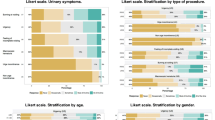Abstract
The objective of this study was to assess the functional efficacy of newly developed antirefluxive ureter stents (DJ), by performing immediate post-stenting cystograms on patients with acute ureteral obstruction requiring a DJ stent, and assessing stent-related symptoms by means of ureteral stent symptoms questionnaire (USSQ). Patients with acute hydronephrosis requiring internal drainage were randomized to receive either an antirefluxive DJ or a conventional DJ (7 Fr., 26 cm, polyurethane, Urovision®, Germany). Mean stone size was 6.64 ± 3.33 and 6.5 ± 3.54 mm. Immediately after correct placement of the DJ, 200 ml of diluted contrast media was introduced into the bladder under fluoroscopic control to detect vesicoureteral reflux (VUR). Patients completed German versions of the USSQ on days 2 and 7 following stent placement, and 1 week after stent removal. The results were analyzed. 13 conventional and 16 antirefluxive stents were placed in 29 patients. Reflux was documented in eight conventionally stented patients (62.5%). Two of the 16 patients with antirefluxive stents (22%) presented reflux. 1 week after stent implantation, the mean pain value was 1.1 in the antirefluxive group and 3 in the standard group (p < 0.062). Flank pain during micturition occurred after 2 days in seven patients (58%) with standard stents and in three patients (33%) with antirefluxive stents (p < 0.23). 1 week after stent insertion, flank pain had dropped to 40% in the standard group and 11% in the antirefluxive group (p < 0.3). Our initial experience showed that the antirefluxive system might be effective in terms of reflux prevention and reduction of stent related symptoms especially during sexual intercourse.



Similar content being viewed by others
Abbreviations
- cm:
-
Centimeter
- DJ:
-
Ureter stent
- Fr.:
-
French
- ml:
-
Milliliter
- mm:
-
Millimeter
- No.:
-
Number
- USSQ:
-
Ureteral stent symptoms questionnaire
- VUR:
-
Vesicoureteral reflux
- y:
-
Years
References
Zimskind PD, Fetter TR, Wilkerson JL (1967) Clinical use of long-term indwelling silicone rubber ureteral splints inserted cystoscopically. J Urol 97(5):840–844
Chew BH, Knudsen BE, Denstedt JD (2004) The use of stents in contemporary urology. Curr Opin Urol 14(2):111–115. doi:10.1097/00042307-200403000-00011
Chew BH, Knudsen BE, Nott L, Pautler SE, Razvi H, Amann J, Denstedt JD (2007) Pilot study of ureteral movement in stented patients: first step in understanding dynamic ureteral anatomy to improve stent comfort. J Endourol 21(9):1069–1075. doi:10.1089/end.2006.0252
Joshi HB, Okeke A, Newns N, Keeley FX Jr, Timoney AG (2002) Characterization of urinary symptoms in patients with ureteral stents. Urology 59(4):511–516. doi:S0090429501016442
Joshi HB, Stainthorpe A, MacDonagh RP, Keeley FX Jr, Timoney AG, Barry MJ (2003) Indwelling ureteral stents: evaluation of symptoms, quality of life and utility. J Urol 169(3):1065–1069. doi:10.1097/01.ju.0000048980.33855.90
Chew BH, Lange D (2009) Ureteral stent symptoms and associated infections: a biomaterials perspective. Nat Rev Urol 6(8):440–448. doi:10.1038/nrurol.2009.124
Ho CH, Chen SC, Chung SD, Lee YJ, Chen J, Yu HJ, Huang KH (2008) Determining the appropriate length of a double-pigtail ureteral stent by both stent configurations and related symptoms. J Endourol 22(7):1427–1431. doi:10.1089/end.2008.0037
Ahmadzadeh M (1992) Flap valve ureteral stent with an antireflux function: a review of 46 cases. Urol Int 48(4):466–468
Joshi HB, Newns N, Stainthorpe A, MacDonagh RP, Keeley FX Jr, Timoney AG (2003) Ureteral stent symptom questionnaire: development and validation of a multidimensional quality of life measure. J Urol 169(3):1060–1064. doi:10.1097/01.ju.0000049198.53424
Dyer RB, Chen MY, Zagoria RJ, Regan JD, Hood CG, Kavanagh PV (2002) Complications of ureteral stent placement. Radiographics 22(5):1005–1022
Deliveliotis C, Chrisofos M, Gougousis E, Papatsoris A, Dellis A, Varkarakis IM (2006) Is there a role for alpha1-blockers in treating double-J stent-related symptoms? Urology 67(1):35–39. doi:S0090-4295(05)01142-8
Maan Z, Patel D, Moraitis K, El-Husseiny T, Papatsoris AG, Buchholz NP, Masood J (2010) Comparison of stent-related symptoms between conventional Double-J stents and a new-generation thermoexpandable segmental metallic stent: a validated-questionnaire-based study. J Endourol 24(4):589–593. doi:10.1089/end.2009.0318
Yossepowitch O, Lifshitz DA, Dekel Y, Ehrlich Y, Gur U, Margel D, Livne PM, Baniel J (2005) Assessment of vesicoureteral reflux in patients with self-retaining ureteral stents: implications for upper urinary tract instillation. J Urol 173(3):890–893. doi:10.1097/01.ju.0000147747.89028.64
Brewer AV, Elbahnasy AM, Bercowsky E, Maxwell KL, Shalhav AL, Kahn SA, McDougall EM, Clayman RV (1999) Mechanism of ureteral stent flow: a comparative in vivo study. J Endourol 13(4):269–271
Olweny EO, Landman J, Andreoni C, Collyer W, Kerbl K, Onciu M, Valimaa T, Clayman RV (2002) Evaluation of the use of a biodegradable ureteral stent after retrograde endopyelotomy in a porcine model. J Urol 167(5):2198–2202. doi:S0022-5347(05)65128-2
Hubner WA, Plas EG, Stoller ML (1992) The double-J ureteral stent: in vivo and in vitro flow studies. J Urol 148(2 Pt 1):278–280
Conflict of interest
No competing financial interests exist.
Author information
Authors and Affiliations
Corresponding author
Rights and permissions
About this article
Cite this article
Ritter, M., Krombach, P., Knoll, T. et al. Initial experience with a newly developed antirefluxive ureter stent. Urol Res 40, 349–353 (2012). https://doi.org/10.1007/s00240-011-0415-5
Received:
Accepted:
Published:
Issue Date:
DOI: https://doi.org/10.1007/s00240-011-0415-5




